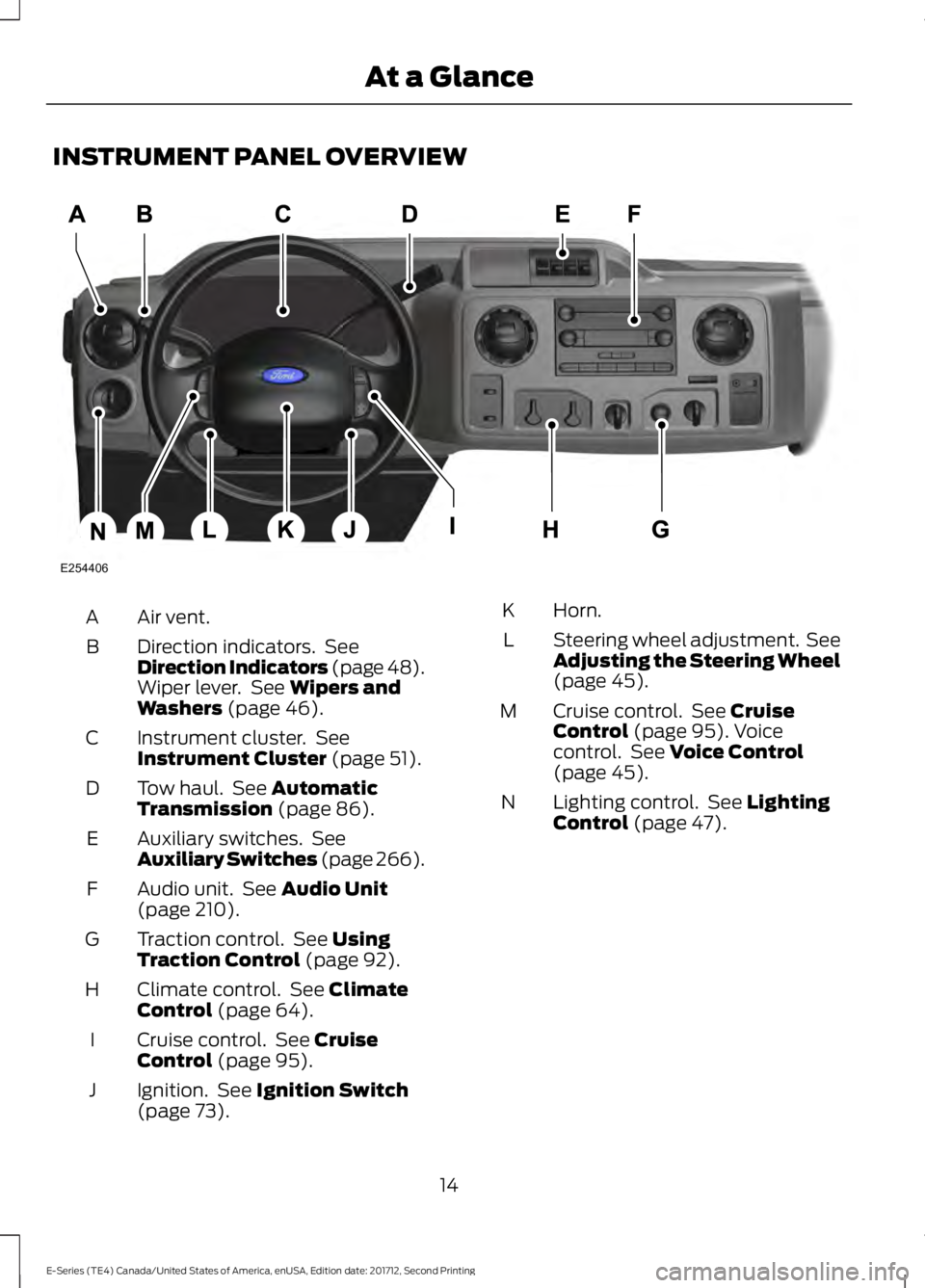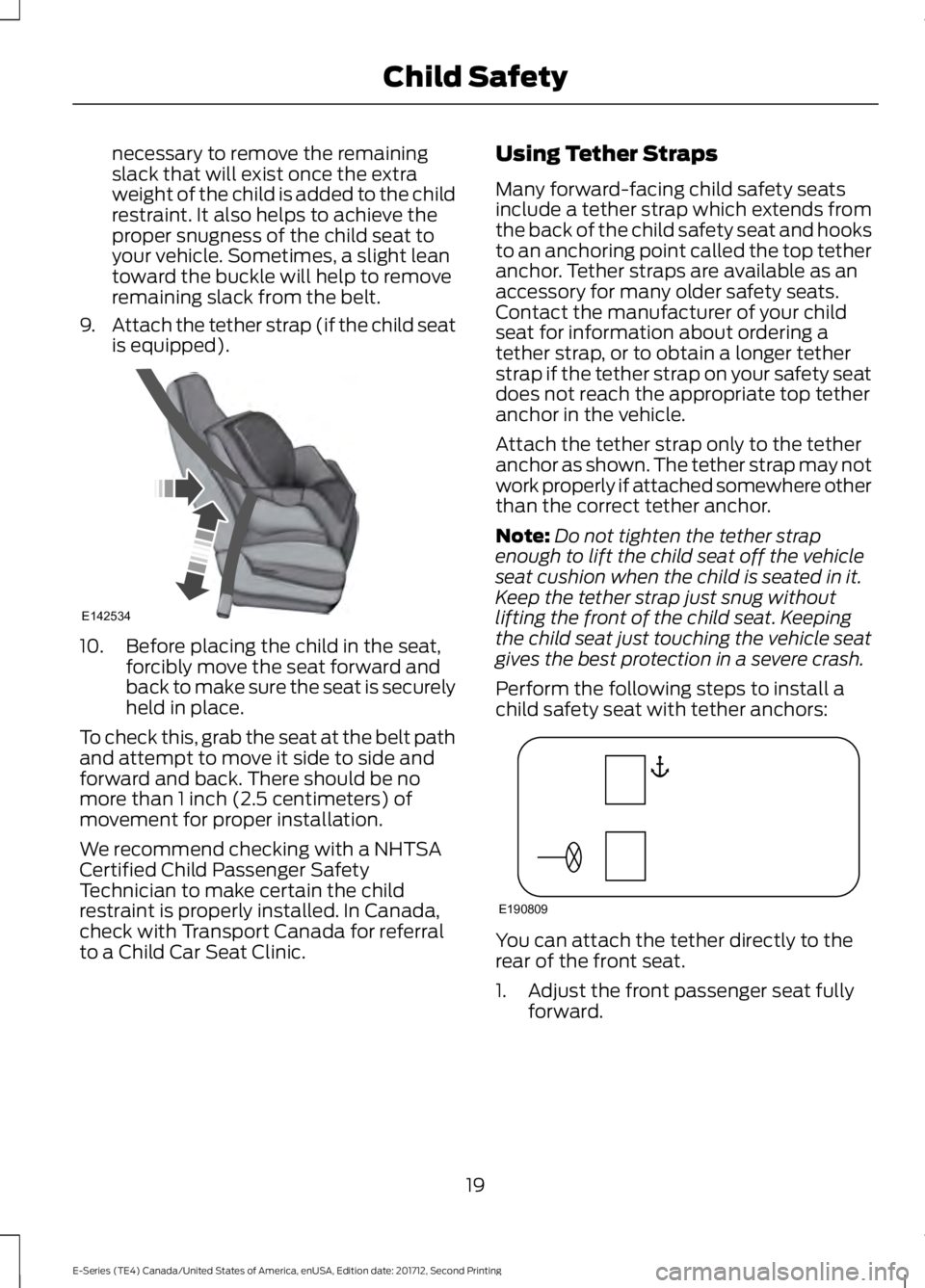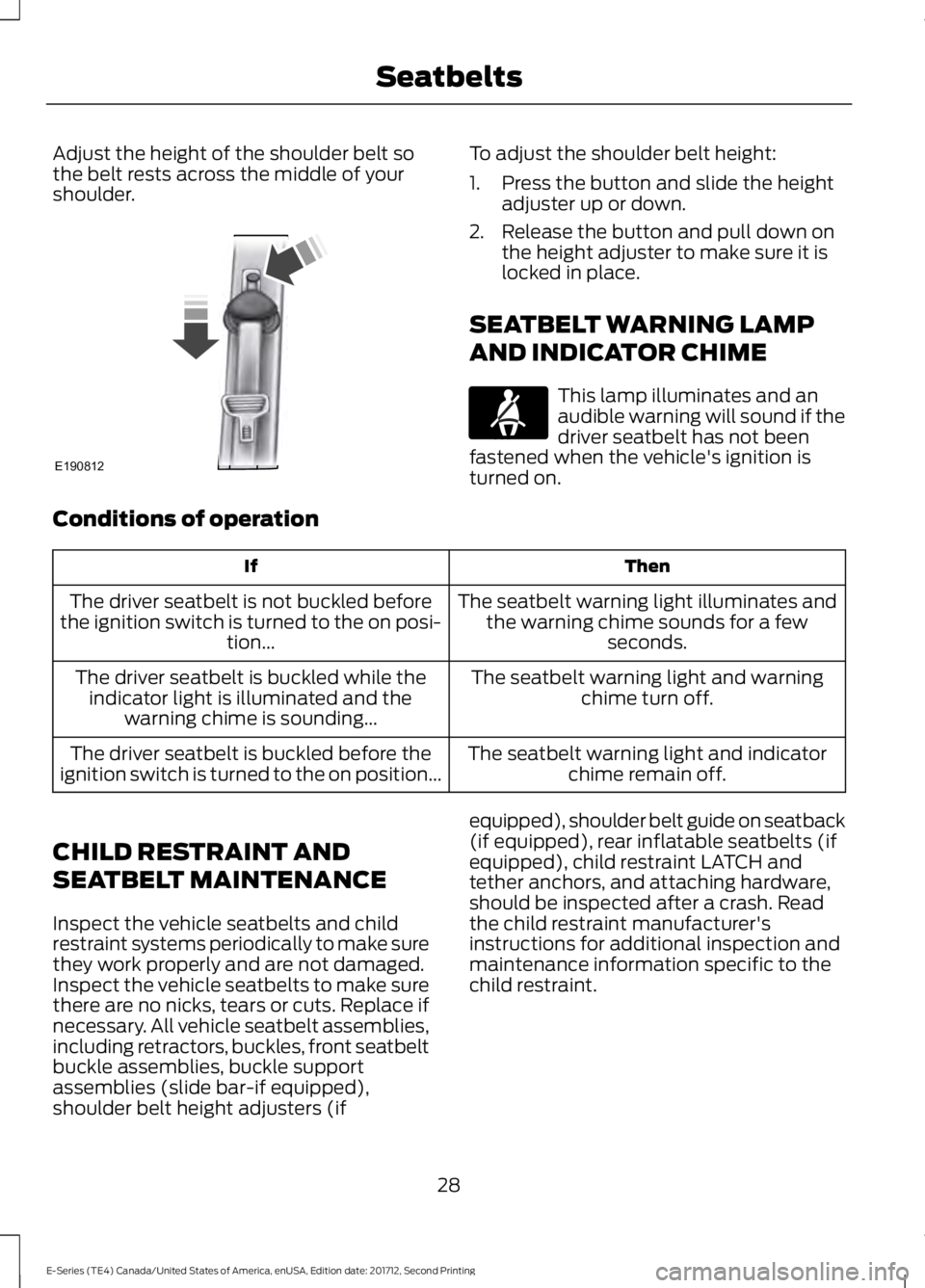2018 FORD E-450 light
[x] Cancel search: lightPage 4 of 323

Introduction
About This Manual
..........................................5
Symbols Glossary ............................................
5
Data Recording ..................................................
7
California Proposition 65 ..............................
9
Perchlorate .........................................................
9
Ford Credit ..........................................................
9
Replacement Parts Recommendation ........................................................................\
...
10
Special Notices ...............................................
10
Mobile Communications Equipment ........................................................................\
....
12
Environment
Protecting the Environment .......................
13
At a Glance
Instrument Panel Overview .......................
14
Child Safety
General Information ......................................
15
Installing Child Restraints ...........................
16
Booster Seats .................................................
20
Child Restraint Positioning .........................
22
Seatbelts
Principle of Operation ..................................
25
Fastening the Seatbelts .............................
26
Seatbelt Height Adjustment .....................
27
Seatbelt Warning Lamp and Indicator Chime ............................................................
28
Child Restraint and Seatbelt Maintenance ...............................................
28
Seatbelt Extension .......................................
29
Supplementary Restraints System
Principle of Operation .................................
30
Driver and Passenger Airbags ....................
31
Crash Sensors and Airbag Indicator .......
36Airbag Disposal
..............................................
36
Keys and Remote Controls
General Information on Radio Frequencies .................................................
37
Remote Control ..............................................
37
Replacing a Lost Key or Remote Control ........................................................................\
..
39
Doors and Locks
Locking and Unlocking ...............................
40
Security
Passive Anti-Theft System ........................
43
Steering Wheel
Adjusting the Steering Wheel ..................
45
Voice Control ..................................................
45
Cruise Control .................................................
45
Wipers and Washers
Windshield Wipers .......................................
46
Windshield Washers ....................................
46
Lighting
General Information .....................................
47
Lighting Control ..............................................
47
Instrument Lighting Dimmer ....................
48
Daytime Running Lamps ...........................
48
Direction Indicators ......................................
48
Windows and Mirrors
Power Windows ............................................
49
Exterior Mirrors ...............................................
49
Interior Mirror ..................................................
50
Sun Visors ........................................................
50
Instrument Cluster
Gauges ...............................................................
51
Warning Lamps and Indicators ................
52
1
E-Series (TE4) Canada/United States of America, enUSA, Edition date: 201712, Second Printing Table of Contents
Page 9 of 323

Brake system
Cabin air filter
Check fuel cap
Child safety door lock or unlock
Child seat lower anchor
Child seat tether anchor
Cruise control
Do not open when hot
Engine air filter
Engine coolant
Engine coolant temperature
Engine oil
Explosive gas
Fan warning Fasten seatbelt
Flammable
Front airbag
Front fog lamps
Fuel pump reset
Fuse compartment
Hazard flashers
Heated rear window
Windshield defrosting system
Interior luggage compartment
release
Jack
Keep out of reach of children
Lighting control
Low tire pressure warning
Maintain correct fluid level
6
E-Series (TE4) Canada/United States of America, enUSA, Edition date: 201712, Second Printing Introduction E270480 E71340 E71880 E231160 E67017 E161353
Page 13 of 323

We offer a number of convenient ways for
you to contact us, and to manage your
account.
Call 1-800-727-7000.
For more information about Ford Credit
and access to Account Manager, go to
www.ford.com/finance.
REPLACEMENT PARTS
RECOMMENDATION
We have built your vehicle to the highest
standards using quality parts. We
recommend that you demand the use of
genuine Ford and Motorcraft parts
whenever your vehicle requires scheduled
maintenance or repair. You can clearly
identify genuine Ford and Motorcraft parts
by looking for the Ford, FoMoCo or
Motorcraft branding on the parts or their
packaging.
Scheduled Maintenance and
Mechanical Repairs
One of the best ways for you to make sure
that your vehicle provides years of service
is to have it maintained in line with our
recommendations using parts that
conform to the specifications detailed in
this Owner
’s Manual. Genuine Ford and
Motorcraft parts meet or exceed these
specifications.
Collision Repairs
We hope that you never experience a
collision, but accidents do happen.
Genuine Ford replacement collision parts
meet our stringent requirements for fit,
finish, structural integrity, corrosion
protection and dent resistance. During vehicle development we validate that
these parts deliver the intended level of
protection as a whole system. A great way
to know for sure you are getting this level
of protection is to use genuine Ford
replacement collision parts.
Warranty on Replacement Parts
Genuine Ford and Motorcraft replacement
parts are the only replacement parts that
benefit from a Ford Warranty. The Ford
Warranty may not cover damage caused
to your vehicle as a result of failed
non-Ford parts. For additional information,
refer to the terms and conditions of the
Ford Warranty.
SPECIAL NOTICES
New Vehicle Limited Warranty
For a detailed description of what is
covered and what is not covered by your
vehicle
’s New Vehicle Limited Warranty,
see the Warranty Guide that is provided
to you along with your Owner ’s Manual.
Special Instructions
For your added safety, your vehicle is fitted
with sophisticated electronic controls. WARNINGS
You risk death or serious injury to
yourself and others if you do not
follow the instruction highlighted by
the warning symbol. Failure to follow the
specific warnings and instructions could
result in personal injury. Never
place front seat mounted
rear-facing child or infant seats in
front of an active passenger airbag. 10
E-Series (TE4) Canada/United States of America, enUSA, Edition date: 201712, Second Printing Introduction
Page 14 of 323

On Board Diagnostics Data Link
Connector
WARNING
Do not connect wireless plug-in
devices to the data link connector.
Unauthorized third parties could gain
access to vehicle data and impair the
performance of safety related systems.
Only allow repair facilities that follow our
service and repair instructions to connect
their equipment to the data link connector. Your vehicle has an OBD Data Link
Connector (DLC) that is used in
conjunction with a diagnostic scan tool for
vehicle diagnostics, repairs and
reprogramming services. Installing an
aftermarket device that uses the DLC
during normal driving for purposes such as
remote insurance company monitoring,
transmission of vehicle data to other
devices or entities, or altering the
performance of the vehicle, may cause
interference with or even damage to
vehicle systems. We do not recommend
or endorse the use of aftermarket plug-in
devices unless approved by Ford. The
vehicle Warranty will not cover damage
caused by an aftermarket plug-in device.
Notice to Owners of Pickup Trucks
and Utility Type Vehicles
WARNING
Utility vehicles have a significantly
higher rollover rate than other types
of vehicles.
Before you drive your vehicle, please read
this Owner
’s Manual carefully. Your vehicle
is not a passenger car. As with other
vehicles of this type, failure to operate this
vehicle correctly may result in loss of
vehicle control, vehicle rollover, personal
injury or death. Using your Vehicle as an
Ambulance
If your light truck has the Ford Ambulance
Preparation Package, it may be utilized as
an ambulance. Ford urges ambulance
manufacturers to follow the
recommendations of the Ford Incomplete
Vehicle Manual, Ford Truck Body Builder
’s
Layout Book and the Qualified Vehicle
Modifiers (QVM) Guidelines as well as
pertinent supplements. For additional
information, please contact the Truck Body
Builders Advisory Service at
http://www.fleet.ford.com/truckbbas/
and then by selecting Contact Us or by
phone at 1–877 –840–4338.
Use of your Ford light truck as an
ambulance, without the Ford Ambulance
Preparation Package voids the Ford New
Vehicle Limited Warranty and may void
the emissions warranties. In addition,
ambulance usage without the preparation
package could cause high underbody
temperatures, over-pressurized fuel and a
risk of spraying fuel, which could lead to
fires.
If your vehicle has the Ford Ambulance
Preparation Package, it will be indicated
on the Safety Compliance Certification
Label. The label is on the driver side door
pillar or on the rear edge of the driver door.
You can determine whether the
ambulance manufacturer followed Ford ’s
recommendations by directly contacting
that manufacturer.
11
E-Series (TE4) Canada/United States of America, enUSA, Edition date: 201712, Second Printing Introduction
Page 17 of 323

INSTRUMENT PANEL OVERVIEW
Air vent.
A
Direction indicators. See
Direction Indicators (page 48).
Wiper lever. See Wipers and
Washers (page 46).
B
Instrument cluster. See
Instrument Cluster
(page 51).
C
Tow haul. See
Automatic
Transmission (page 86).
D
Auxiliary switches. See
Auxiliary Switches (page 266).
E
Audio unit. See
Audio Unit
(page 210).
F
Traction control. See
Using
Traction Control (page 92).
G
Climate control. See
Climate
Control (page 64).
H
Cruise control. See
Cruise
Control (page 95).
I
Ignition. See
Ignition Switch
(page 73).
J Horn.
K
Steering wheel adjustment. See
Adjusting the Steering Wheel
(page
45).
L
Cruise control. See
Cruise
Control (page 95). Voice
control. See Voice Control
(page 45).
M
Lighting control. See
Lighting
Control (page 47).
N
14
E-Series (TE4) Canada/United States of America, enUSA, Edition date: 201712, Second Printing At a GlanceE254406
Page 22 of 323

necessary to remove the remaining
slack that will exist once the extra
weight of the child is added to the child
restraint. It also helps to achieve the
proper snugness of the child seat to
your vehicle. Sometimes, a slight lean
toward the buckle will help to remove
remaining slack from the belt.
9. Attach the tether strap (if the child seat
is equipped). 10. Before placing the child in the seat,
forcibly move the seat forward and
back to make sure the seat is securely
held in place.
To check this, grab the seat at the belt path
and attempt to move it side to side and
forward and back. There should be no
more than 1 inch (2.5 centimeters) of
movement for proper installation.
We recommend checking with a NHTSA
Certified Child Passenger Safety
Technician to make certain the child
restraint is properly installed. In Canada,
check with Transport Canada for referral
to a Child Car Seat Clinic. Using Tether Straps
Many forward-facing child safety seats
include a tether strap which extends from
the back of the child safety seat and hooks
to an anchoring point called the top tether
anchor. Tether straps are available as an
accessory for many older safety seats.
Contact the manufacturer of your child
seat for information about ordering a
tether strap, or to obtain a longer tether
strap if the tether strap on your safety seat
does not reach the appropriate top tether
anchor in the vehicle.
Attach the tether strap only to the tether
anchor as shown. The tether strap may not
work properly if attached somewhere other
than the correct tether anchor.
Note:
Do not tighten the tether strap
enough to lift the child seat off the vehicle
seat cushion when the child is seated in it.
Keep the tether strap just snug without
lifting the front of the child seat. Keeping
the child seat just touching the vehicle seat
gives the best protection in a severe crash.
Perform the following steps to install a
child safety seat with tether anchors: You can attach the tether directly to the
rear of the front seat.
1. Adjust the front passenger seat fully
forward.
19
E-Series (TE4) Canada/United States of America, enUSA, Edition date: 201712, Second Printing Child SafetyE142534 E190809
Page 28 of 323

PRINCIPLE OF OPERATION
WARNINGS
Always drive and ride with the seat
backrest upright and the lap belt
snug and low across the hips.
To reduce the risk of injury, make
sure children sit where they can be
properly restrained.
Never let a passenger hold a child on
his or her lap while your vehicle is
moving. The passenger cannot
protect the child from injury in a crash
which may result in serious injury or death. All occupants of the vehicle,
including the driver, should always
properly wear their safety belts, even
when an airbag supplemental restraint
system is provided. Failure to properly wear
your safety belt could seriously increase
the risk of injury or death. It is extremely dangerous to ride in a
cargo area, inside or outside of a
vehicle. In a crash, people riding in
these areas are more likely to be seriously
injured or killed. Do not allow people to ride
in any area of your vehicle that is not
equipped with seats and safety belts. Be
sure everyone in your vehicle is in a seat
and using a safety belt properly. In a rollover crash, an unbelted
person is significantly more likely to
die than a person wearing a safety
belt. Each seating position in your vehicle
has a specific safety belt assembly
which is made up of one buckle and
one tongue that are designed to be used
as a pair. 1) Use the shoulder belt on the
outside shoulder only. Never wear the
shoulder belt under the arm. 2) Never
swing the safety belt around your neck over
the inside shoulder. 3) Never use a single
belt for more than one person. WARNINGS
When possible, all children 12 years
old and under should be properly
restrained in a rear seating position.
Failure to follow this could seriously
increase the risk of injury or death. Safety belts and seats can become
hot in a vehicle that has been closed
up in sunny weather; they could burn
a small child. Check seat covers and
buckles before you place a child anywhere
near them. Front and rear seat occupants,
including pregnant women, should
wear safety belts for optimum
protection in an accident. All seating positions in this vehicle have
lap and shoulder safety belts. All
occupants of the vehicle should always
properly wear their safety belts, even when
an airbag supplemental restraint system
is provided.
The safety belt system consists of:
•
Lap and shoulder safety belts.
• Shoulder safety belt with automatic
locking mode, (except driver safety
belt).
• Height adjuster at the front outboard
seating positions.
• Safety belt pretensioner at the front
outboard seating positions. •
Safety belt warning light and chime. •
Crash sensors and monitoring system
with readiness indicator.
25
E-Series (TE4) Canada/United States of America, enUSA, Edition date: 201712, Second Printing SeatbeltsE71880 E67017
Page 31 of 323

Adjust the height of the shoulder belt so
the belt rests across the middle of your
shoulder. To adjust the shoulder belt height:
1. Press the button and slide the height
adjuster up or down.
2. Release the button and pull down on the height adjuster to make sure it is
locked in place.
SEATBELT WARNING LAMP
AND INDICATOR CHIME This lamp illuminates and an
audible warning will sound if the
driver seatbelt has not been
fastened when the vehicle's ignition is
turned on.
Conditions of operation Then
If
The seatbelt warning light illuminates andthe warning chime sounds for a few seconds.
The driver seatbelt is not buckled before
the ignition switch is turned to the on posi- tion...
The seatbelt warning light and warningchime turn off.
The driver seatbelt is buckled while the
indicator light is illuminated and the warning chime is sounding...
The seatbelt warning light and indicatorchime remain off.
The driver seatbelt is buckled before the
ignition switch is turned to the on position...
CHILD RESTRAINT AND
SEATBELT MAINTENANCE
Inspect the vehicle seatbelts and child
restraint systems periodically to make sure
they work properly and are not damaged.
Inspect the vehicle seatbelts to make sure
there are no nicks, tears or cuts. Replace if
necessary. All vehicle seatbelt assemblies,
including retractors, buckles, front seatbelt
buckle assemblies, buckle support
assemblies (slide bar-if equipped),
shoulder belt height adjusters (if equipped), shoulder belt guide on seatback
(if equipped), rear inflatable seatbelts (if
equipped), child restraint LATCH and
tether anchors, and attaching hardware,
should be inspected after a crash. Read
the child restraint manufacturer's
instructions for additional inspection and
maintenance information specific to the
child restraint.
28
E-Series (TE4) Canada/United States of America, enUSA, Edition date: 201712, Second Printing SeatbeltsE190812 E71880